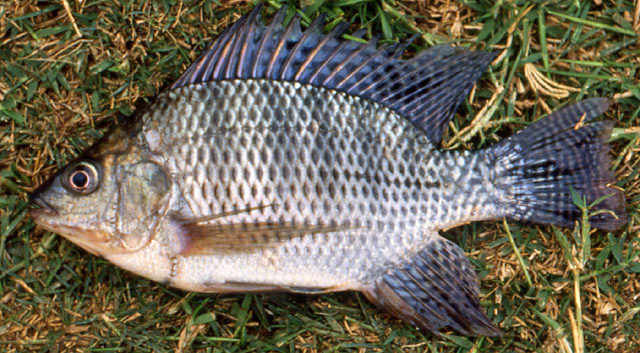| Cichlidae (Cichlids), subfamily: Pseudocrenilabrinae |
| 60 cm SL (male/unsexed); max.weight: 4,324.0 g; max. reported age: 9 years |
|
benthopelagic; freshwater; brackish; depth range 0 - 20 m, potamodromous |
| Africa: naturally occurring in coastal rivers of Israel (Ref. 5166), Nile basin (including lake Albert, Edward and Tana), Jebel Marra, Lake Kivu, Lake Tanganyika, Awash River, various Ethiopian lakes, Omo River system, Lake Turkana, Suguta River and Lake Baringo (Ref. 2). In West Africa natural distribution covers the basins of the Senegal, Gambia, Volta, Niger, Benue and Chad, with introduced specimens reported from various coastal basins (Ref. 53405). Widely introduced for aquaculture, with many existing strains. Several countries report adverse ecological impact after introduction. The following subspecies were previously recognized: Oreochromis niloticus baringoensis, Oreochromis niloticus cancellatus, Oreochromis niloticus eduardianus, Oreochromis niloticus filoa, Oreochromis niloticus niloticus, Oreochromis niloticus sugutae, Oreochromis niloticus tana and Oreochromis niloticus vulcani. |
|
Dorsal spines (total): 15-18; Dorsal soft rays (total): 11-13; Anal spines: 3-3; Anal soft rays: 9-11; Vertebrae: 30-32. Diagnosis: A large deep-bodied tilapia, with a relatively small head (Ref. 118638). Jaws of mature male not greatly enlarged, length of lower jaw 29-37% of head length; genital papilla of breeding male not tassellated (Ref. 2). Body depth 36-50% of SL (Ref. 28714). Most distinguishing characteristic is the presence, at all life stages, of regular vertical stripes throughout depth of caudal fin (Ref. 4967, 53405, 118638). In smaller fishes, these are relatively wide and form an arc, and start at the base of the caudal fin (Ref. 118638). Males are bluish pink, sometimes with a dark throat, belly, anal and pelvic fins; females are usually brownish, silvery/white beneath with around 10 thin vertical bars (Ref. 118638).
Description: Lower pharyngeal bone longer than broad, its anterior part longer than toothed part; outer jaw teeth bicuspid, inner jaw teeth tricuspid, posterior pharyngeal teeth bicuspid and stout; 3-4 rows of teeth in jaws (3-5, rarely 6, in specimens over 200 mm SL); micro-gillrakers present; scales cycloid (Ref. 53405).
Coloration: margin of dorsal fin grey or black; vertical bars in caudal fin 7-12 (Ref. 2). Regular black cross bars on caudal fin; ground colour greyish, relatively dark in adults; back olivaceous-green, sides paler, with 6-9 rather indistinct cross bars; belly whitish; upper lip pale green or white, lower lip white; dorsal and anal fins greyish, sometimes with very narrow red margin, soft part of fin with vertical lines (or with aligned light spots resembling striped pattern); pelvic fins grey, pectorals transparent; "tilapian" spot lacking in adults but very distinct in fingerlings which also have more distinct cross bars and very prominent black spot on upper part of caudal peduncle; throat, belly and unpaired fins black in mature males (Ref. 53405). Head and trunk in breeding male suffused with red (Ref. 28714). |
| Occurs in a wide variety of freshwater habitats like rivers, lakes, sewage canals and irrigation channels (Ref. 28714). Does not do well in pure salt water, but is able to survive in brackish water (Ref. 52307). Mainly diurnal. Feeds mainly on phytoplankton or benthic algae. Additionally, insect larvae are of some importance, as are aufwuchs and detritus; juveniles tend to be more omnivorous than adults (Ref. 52307). Oviparous (Ref. 205), ovophilic (Ref. 52307). A maternal mouthbrooder (Ref. 2, 28714, 52307, 118638), males dig simple pits in shallow water (Ref. 118638). May mature early (about 11 cm TL females, 14 cm TL males) (Ref. 28714). Globally, the most important tilapia species in fish farming and supports major capture fisheries where established; generally highly invasive and known to hybridise with many other Oreochromis species and for this reason further stocking has been banned in a number of countries, e.g. South Africa, Malawi and Zambia (Ref. 118638). Extended temperature range 8-42 °C, natural temperature range 13.5 - 33 °C (Ref. 3). Maximum depth from Ref. 34290. Marketed fresh and frozen (Ref. 9987). |
|
Least Concern (LC); Date assessed: 06 April 2020 Ref. (130435)
|
| potential pest |
|
Introduced in 1970. Reintroduced in 1972 from Thailand (Ref. 6096) and in 1973 from Israel (Ref. 1739). Widely cultured throughout the country especially in Laguna de Bay (Ref. 80824) area in Manila and in Central Luzon. Recorded from Candaba Swamp and Pampanga River (Ref. 109918). May have played a part in the extinction of cyprinids in Lake Lanao, Mindanao (Ref. 10888). Introduced to Lake Mainit (Ref. 4867, 50320, 13446, 81829). Found in Kalinawan River (Ref. 81829). Introduced to Taal Lake, stocked from fingerlings, and had escaped from the cages (Ref. 12165). No adverse impact on indigenous species in Taal lake has been reported (Ref. 27799,81207,13446). Specimens were collected in 1993 from Ambacan River at Makinhas and Butigan, Leyte (Ref. 7223). Reported from San Miguel Bay (Ref. 45161), Panguil Bay (Ref. 47691), Lake Lanao (Ref. 13446, 95183) and Lake Naujan (Ref. 13446, 81887). Abundant in Lake Manguao, Taytay, Palawan in a 2003 study; both an omnivore and planktivore (Ref. 50862). Cultured in reservoirs (Ambuklao, Angat, Binga, Caliraya, and Lumot (Ref. 13464). Collected from CLSU fish pond, Nueva Ecija as specimen for living fish museum.(Ref. 81820). Also recorded from Pampanga River, Paitan Lake, Pantabangan Dam, Tabuating River and Talavera River (Nueva Ecija) (Ref. 109918). Museum specimens collected in 1984 from various localities, LRS-84131(Ref. 13460). Also Ref. 1739, 9987, 58652. |
Source and more info: www.fishbase.org. For personal, classroom, and other internal use only. Not for publication.

